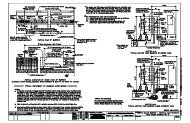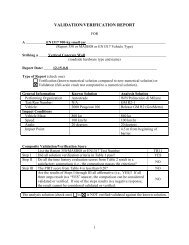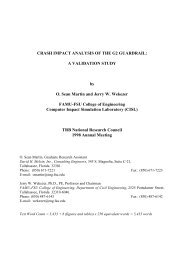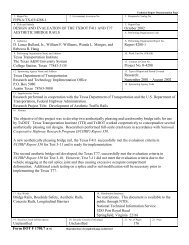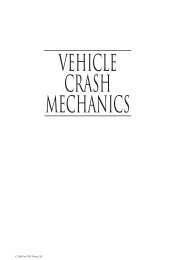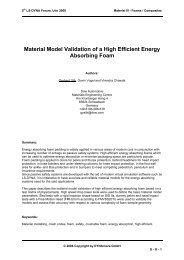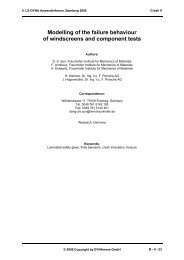Vehicle Crashworthiness and Occupant Protection - Chapter 3
Vehicle Crashworthiness and Occupant Protection - Chapter 3
Vehicle Crashworthiness and Occupant Protection - Chapter 3
Create successful ePaper yourself
Turn your PDF publications into a flip-book with our unique Google optimized e-Paper software.
Finite Element Analytical Techniques<br />
<strong>and</strong> Applications to Structural Design<br />
necessary to account for the correct inertial response of the wheel. The wheel can<br />
become a major load path in offset or oblique frontal crash events. Therefore, the<br />
tire stiffness must be accurately simulated. The air in the tire is simulated using<br />
the airbag algorithms of the explicit codes, yielding the pressure of a constant<br />
amount of air in the tire as a function of the compressed volume, assuming<br />
isothermal or isentropic conditions. A remaining problem is in the material model<br />
of the tires themselves. Existing tire models are far too complex to be incorporated<br />
in full vehicle crash models, <strong>and</strong> research is needed to generate reasonable <strong>and</strong><br />
efficient approximations.<br />
The third primary system to be modeled for a full vehicle simulation is the steering<br />
system including the steering rack, steering column <strong>and</strong> steering wheel. For the<br />
steering rack <strong>and</strong> its connections to the wheel knuckle, the same remarks are valid<br />
as for the modeling of the front <strong>and</strong> rear axles. A correct modeling of outer contours<br />
releasing the correct degrees of freedom in the connections using joint <strong>and</strong>/or<br />
spring elements is usually considered sufficient. Rarely, a detailed model is built<br />
that couples the translational motion of the steering rack to the rotation of the<br />
wheels. This can be of importance in the study of frontal offset <strong>and</strong> oblique<br />
impacts. Very often, a steering rack model that is fixed to the subframe structure is<br />
used, thus effectively blocking the wheel rotation. The steering column is usually<br />
modeled as a set of cylindrical tubes sliding in each other. It is this sliding motion<br />
that simulates the telescopic deformation of the steering column as the dummy<br />
hits the steering wheel.<br />
To simulate the Cardan joints in the steering column, the exact geometry of the<br />
device is usually modeled with contact algorithms automatically accounting for<br />
the so-called stop-angles.<br />
Observation has shown that engine motion is crucial for the dummy response in<br />
the passenger compartment during a frontal impact. Engine motion, in turn, is at<br />
least partly determined by contacts with the structure <strong>and</strong> other components<br />
located under the hood. Consequently, these components must be modeled<br />
carefully <strong>and</strong> with mesh sizes that are not very different from the engine block<br />
mesh size. These components include the battery, radiator, air conditioning unit,<br />
automatic braking system unit, ventilators <strong>and</strong> electro-engines at the radiator,<br />
radiator bracket <strong>and</strong> light brackets. Some of these are mild steel structures <strong>and</strong><br />
can be modeled as such. Others are hard points <strong>and</strong> little care must be given to<br />
the determination of their stiffness as long as the resulting strength is considerably<br />
higher than that of the surrounding structural parts. An exception is the radiator<br />
model, which must crush under the impact of the engine block <strong>and</strong> somewhat<br />
damp its acceleration response. Equivalent models based on force-displacement<br />
Page 129



